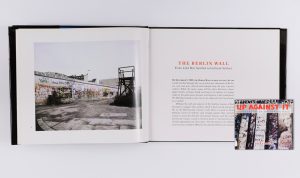Documento Mês – Fundo Bibliográfico

Revolução na Fotografia: Kodak desenvolve a primeira câmArte no Muro de Berlim: Expressões durante a Guerra Friaera digital em 1975
Sabia que a parte ocidental do Muro de Berlim tornou-se uma superfície para os artistas expressarem a sua arte?
Durante a Guerra Fria, que estabeleceu uma divisão ideológica entre os Estados Unidos (bloco capitalista) e a União Soviética (bloco comunista) sem confrontos militares diretos, o Muro de Berlim, erguido a partir de 1961, foi construído para evitar a fuga da população para o lado capitalista, tornando-se um símbolo da complexa conjuntura geopolítica da época.
Em 1983, o fotógrafo norte-americano Leland Rice (1940) iniciou uma extensa série fotográfica do Muro de Berlim. Anualmente, regressava para registar a constante evolução de imagens, de grafites, de pictogramas, de poesia e slogans no Muro de Berlim até à sua queda em novembro de 1989. Leland Rice designava-se a si próprio como “antropólogo visual” no âmbito do seu projeto fotográfico sobre o Muro de Berlim, dedicando-se à documentação e interpretação visual da cultura e sociedade refletidas nas imagens e mensagens presentes no Muro.
A queda do Muro de Berlim em 1989, após cerca de 28 anos, foi motivada pela pressão popular, reformas políticas e económicas, mudanças internacionais e um erro de comunicação que levou à abertura das fronteiras. Após esse acontecimento, artistas de todo o mundo dirigiram-se a Berlim para deixarem a sua marca na cidade.
Revolution in Photography: Kodak Develops the FiArt on the Berlin Wall: Expressions During the Cold Warrst Digital Camera in 1975
Did you know that the western part of the Berlin Wall became a surface for artists to express their art?
During the Cold War, which established an ideological division between the United States (capitalist bloc) and the Soviet Union (communist bloc) without direct military confrontations, the Berlin Wall was built from 1961 onwards to prevent the population from fleeing to the capitalist side, becoming a symbol of the complex geopolitical situation of the time.
In 1983, the American photographer Leland Rice (1940) began an extensive photographic series focusing on the Berlin Wall. Each year, he returned to document the ongoing evolution of images, graffiti, pictograms, poetry, and slogans on the Berlin Wall until its fall in November 1989. Leland Rice referred to himself as a ‘visual anthropologist’ within the scope of his photographic project on the Berlin Wall, dedicating himself to the visual documentation and interpretation of the culture and society reflected in the images and messages present on the Wall.
The fall of the Berlin Wall in 1989, after about 28 years, was motivated by popular pressure, political and economic reforms, international changes, and a communication error that led to the opening of the borders. Following this event, artists from around the world flocked to Berlin to leave their mark on the city.